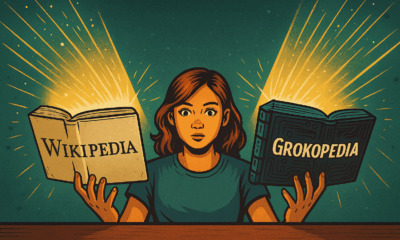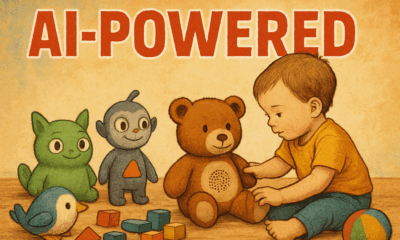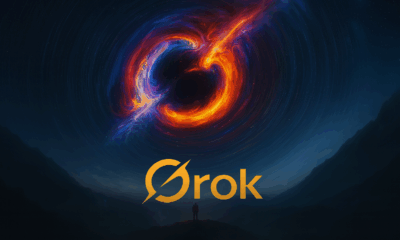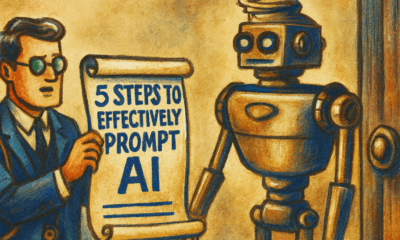AI Model
Grok 4 Unveiled: A Leap Forward in AI
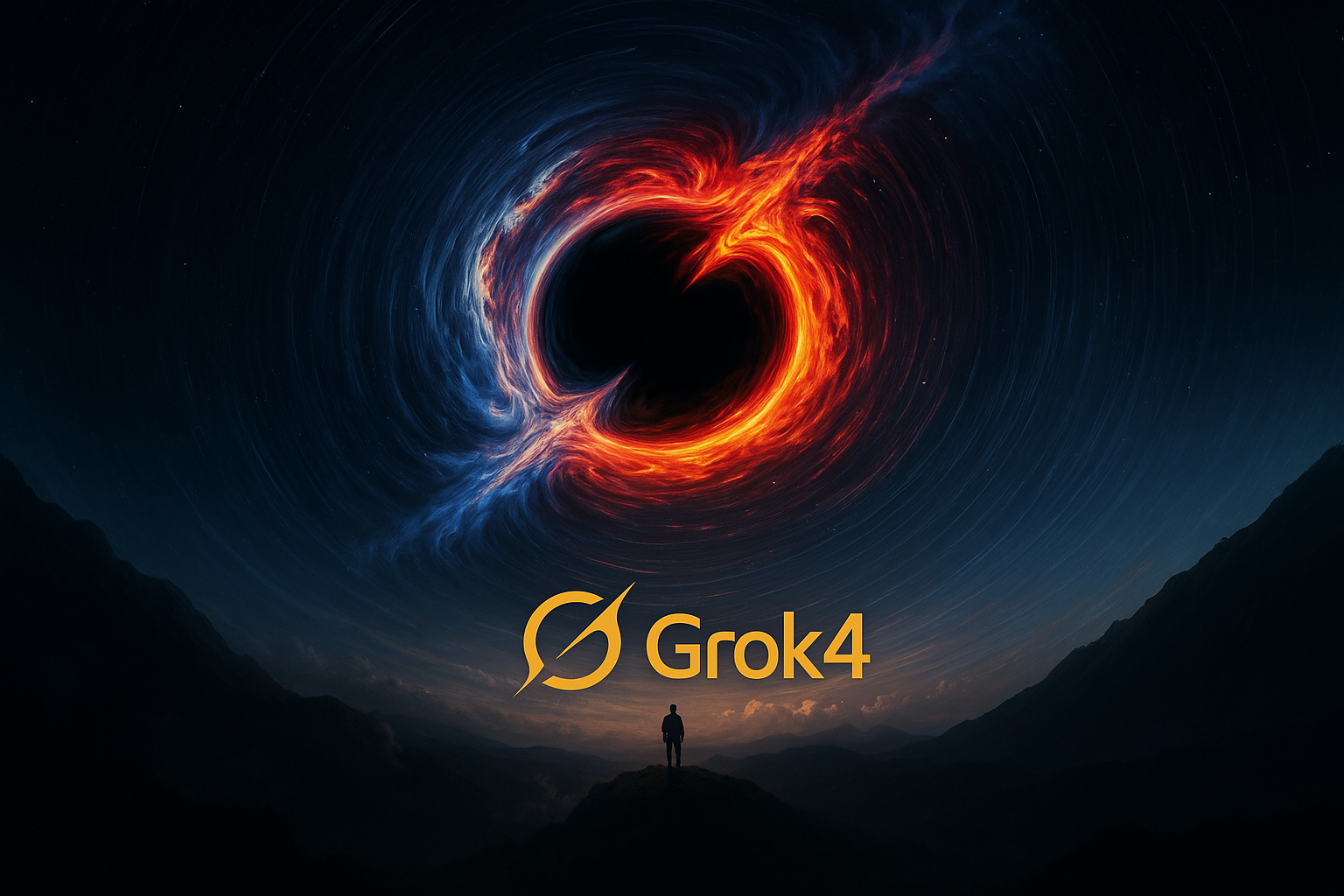
- Share
- Tweet /data/web/virtuals/375883/virtual/www/domains/spaisee.com/wp-content/plugins/mvp-social-buttons/mvp-social-buttons.php on line 63
https://spaisee.com/wp-content/uploads/2025/07/grok44-1000x600.png&description=Grok 4 Unveiled: A Leap Forward in AI', 'pinterestShare', 'width=750,height=350'); return false;" title="Pin This Post">
In the fast-paced world of artificial intelligence, xAI’s Grok 4 emerges as a noteworthy contender. Developed by xAI, this latest iteration builds on the groundwork of Grok 3, introducing a host of advanced features designed to enhance user experience and functionality. This article explores the key aspects of Grok 4, its improvements over its predecessor, and its anticipated integration with the X platform.
The AI Landscape: Setting the Stage for Grok 4
The launch of Grok 4 comes amid a transformative period for AI. Over the past decade, advancements in machine learning have propelled AI from academic curiosity to a cornerstone of modern technology. Models like OpenAI’s GPT-4o and Google’s Gemini have set benchmarks in natural language understanding, while specialized AIs have emerged for tasks like medical diagnostics and autonomous driving. Yet, the field remains fiercely competitive, with each new release scrutinized for its ability to outpace rivals in accuracy, versatility, and real-world utility.
xAI enters this fray with a distinct philosophy. Unlike some competitors focused on broad commercialization, xAI emphasizes creating AI that “thinks” and reasons from first principles—a nod to Musk’s engineering mindset. Since the debut of Grok 1 in 2023, xAI has iterated rapidly, with each version refining its predecessor’s capabilities. Grok 3, released in mid-2024, gained attention for its conversational fluency and ability to handle complex queries, but it lacked the multimodal and coding-specific features that Grok 4 now introduces. Against this backdrop, Grok 4’s launch on July 10, 2025, is not just a product reveal—it’s a statement of xAI’s intent to lead the next wave of AI innovation.
Grok 4’s Cutting-Edge Features: A Closer Look
Grok 4 arrives with a suite of features designed to appeal to diverse users, from casual enthusiasts to hardcore developers. Here’s a detailed breakdown of what’s new:
1. Grok 4 Code: A Developer’s Dream
The standout addition is the Grok 4 Code model, a specialized variant built for software developers. This model offers advanced capabilities in:
- Code Generation: Grok 4 Code can write code in multiple programming languages based on natural language prompts, such as “Create a Python script to sort a list of integers.”
- Debugging: It identifies errors in existing code and suggests fixes, streamlining the troubleshooting process.
- Autonomous Task Execution: Integrated with IDEs like Cursor, Grok 4 Code can autonomously perform tasks like optimizing algorithms or refactoring code, reducing manual workload.
For example, imagine a developer tasked with building a web application. They could ask Grok 4 Code to generate the HTML, CSS, and JavaScript framework, debug a malfunctioning function, and optimize the code for performance—all within their IDE. Early estimates suggest a 20% boost in accuracy over Grok 3 for these tasks, making Grok 4 Code a potential game-changer for software development.
2. Enhanced Reasoning for Complex Queries
Beyond coding, Grok 4 sharpens its reasoning capabilities. It’s been trained on an expanded dataset to handle complex mathematical and scientific queries with greater precision. Whether solving multi-step equations or explaining quantum mechanics, Grok 4 aims to deliver accurate, step-by-step answers. This improvement addresses a common critique of earlier models, which sometimes faltered on intricate problems requiring logical leaps.
3. Multimodal Capabilities: Voice and Vision
Grok 4 introduces voice interaction and image generation, marking its transition into a multimodal AI. Users can:
- Speak to Grok: Ask questions naturally via voice and receive spoken responses, ideal for hands-free use or accessibility.
- Generate Images: Request visual content, such as diagrams or illustrations, based on prompts like “Draw a graph of exponential growth.”
Picture a student asking, “What’s the greenhouse effect?” Grok 4 could reply aloud with a clear explanation and generate a diagram showing CO2 trapping heat in the atmosphere. These features, absent in Grok 3, make Grok 4 more intuitive and versatile, aligning it with competitors like GPT-4o, which also supports multimodal inputs.
4. Bias Reduction and Accuracy Improvements
xAI has refined Grok 4’s training data to minimize bias and boost reliability. This addresses a persistent challenge in AI: ensuring responses are factual and neutral. While no AI is immune to scrutiny, Grok 4’s improvements in this area could enhance trust among users who rely on it for critical information.
What Users Can Expect: A Dual-Model Approach
Grok 4 adopts a dual-model strategy to cater to diverse needs:
- General-Purpose Model: For everyday queries, this version excels in natural language understanding, math, and logic. It’s ideal for users seeking answers to questions like “What’s the history of space exploration?” or “How do I calculate compound interest?”
- Grok 4 Code: Aimed at developers, this model focuses on coding tasks, offering precision and autonomy within development environments.
This approach ensures flexibility. Casual users get a conversational AI that’s smarter and more engaging, while professionals gain a specialized tool tailored to their workflows. The addition of voice interaction and image generation further enhances accessibility. For instance, a teacher could use voice commands to ask Grok 4 for a lesson plan, then request a visual aid—all without typing.
Accuracy is another priority. xAI claims Grok 4 reduces errors in complex queries by leveraging improved reasoning algorithms and cleaner training data. This could make it a go-to resource for students, researchers, and anyone needing dependable answers.
Grok 4 vs. Grok 3: A Leap in Performance
How does Grok 4 stack up against its predecessor? Here’s a detailed comparison:
- Coding Capabilities: Grok 3 offered basic code generation, but Grok 4 Code takes it further with a 20% accuracy boost, debugging support, and autonomous task execution in IDEs. This leap could save developers hours of manual work.
- Reasoning: Grok 4’s enhanced reasoning reduces errors in math and logic, outperforming Grok 3 in early benchmarks. For example, where Grok 3 might stumble on a calculus problem, Grok 4 provides a clearer, more accurate solution.
- Multimodal Features: Grok 3 was text-only, while Grok 4’s voice and image capabilities open new interaction possibilities, making it more dynamic and user-friendly.
- Performance Edge: Preliminary tests suggest Grok 4 surpasses Grok 3—and even rivals like GPT-4o—in key areas like coding, math, and natural language processing.
These upgrades reflect xAI’s response to user feedback and market demands, positioning Grok 4 as a more robust and competitive model.
Launch Details and X Platform Integration
The official launch of Grok 4 is scheduled for July 10, 2025, at 8:00 PM PT (July 10, 8:30 AM IST), with a livestream on xAI’s X account. Hosted by Musk and the xAI team, the event will showcase Grok 4’s capabilities and outline its rollout plan. This high-profile reveal underscores xAI’s confidence in Grok 4 as a flagship product.
Post-launch, Grok 4 will integrate with the X platform, leveraging X’s real-time data to provide timely insights. Users can interact with Grok 4 directly in the X app, asking questions or generating content. X Premium+ subscribers will enjoy perks like:
- Higher usage limits.
- Early access to voice mode and image generation.
For example, during a breaking news event, a Premium+ user could ask Grok 4, “What’s happening with this story?” and get a summary based on the latest X posts—voiced aloud or paired with a visual.
Developers, meanwhile, can tap into Grok 4 via xAI’s API for custom projects, broadening its reach beyond X.
This integration aligns with Musk’s vision of merging AI with social media, potentially transforming how users engage with platforms like X. It also raises questions about data privacy and AI’s role in shaping online discourse—topics worth monitoring as Grok 4 rolls out.
Broader Context: xAI’s Vision and the Future of AI
Grok 4 is more than a product; it’s a milestone in xAI’s mission to advance human discovery. Musk has long championed AI that reasons independently, free from rote learning, and Grok 4 embodies this ethos. Its dual-model design hints at future specialization—perhaps models for medicine, education, or engineering. Rumors also suggest integrations beyond X, such as Telegram or Tesla’s in-car systems, though these remain unconfirmed.
In the broader AI landscape, Grok 4 arrives as ethical and technical debates intensify. Concerns about bias, job displacement, and AI’s societal impact are mounting. xAI’s focus on accuracy and bias reduction is a step forward, but Grok 4 will face scrutiny like its peers. Can it deliver reliable, unbiased outputs at scale? How will it handle misuse risks? These questions linger as the launch nears.
Globally, AI investment is soaring—projected to hit $500 billion by 2026, per industry reports—fueling innovations like Grok 4. Yet, with power comes responsibility. As xAI competes with OpenAI (backed by Microsoft) and Anthropic (founded by ex-OpenAI researchers), Grok 4’s success will hinge on its ability to balance capability with accountability.
Conclusion: A Defining Moment for xAI
Grok 4 is poised to redefine AI’s possibilities, blending advanced features with practical applications. Its dual-model approach, multimodal capabilities, and X integration make it a formidable contender in a crowded field. For developers, it’s a productivity booster; for casual users, it’s a smarter, more engaging assistant. Yet, its true test lies ahead: Can it deliver on its promises and navigate the ethical challenges of modern AI?
Grok 4 could mark a turning point for xAI, solidifying its place among AI pioneers. Whether it reshapes coding, social media, or human-AI interaction, one thing is clear: Grok 4 is a story that’s just beginning.
AI Model
How to Prompt Nano Banana Pro: A Guide to Creating High-Quality Images with Google’s AI

Why Nano Banana Pro Matters
Nano Banana Pro is Google DeepMind’s most advanced image generation model, built on the powerful Gemini 3 Pro architecture. It delivers high-resolution outputs (up to 4K), understands complex prompts with layered context, and performs exceptionally well when generating realistic lighting, textures, and dynamic scenes. It also supports image referencing — letting you upload photos or designs to guide the visual consistency.
In short, it’s not just a toy — it’s a tool for designers, marketers, illustrators, and creatives who want to build professional-grade images fast. But to unlock its full potential, you need to learn how to prompt it properly.
Prompting Basics: Clarity Beats Cleverness
The secret to powerful results isn’t trickery — it’s clarity. Nano Banana Pro doesn’t need keyword spam or obscure syntax. It needs you to be specific and structured.
Here are the key rules to follow:
- Be descriptive, not vague: Instead of “a cat,” write something like “a ginger British shorthair cat sitting on a marble countertop under soft morning light.
- Layer your descriptions: Include details about the subject, setting, atmosphere, materials, lighting, style, and mood.
- State your format: Tell the model if you want a photo, digital painting, cinematic frame, 3D render, infographic, comic panel, etc.
- Use reference images: Nano Banana Pro supports multiple uploads — useful for matching styles, poses, faces, characters, or branding.
This is how professionals prompt: not by hacking the system, but by being precise about what they want.
Crafting Prompts by Use Case
📸 Realistic Photography
Want a product photo, fashion portrait, or cinematic still? Then your prompt should include lens type, lighting style, subject age, composition, and color grading.
Example:
Professional studio portrait of a 35-year-old woman in natural light, soft cinematic lighting, shallow depth of field, 85mm lens look, natural skin tones, soft shadows, clean background, editorial style.
Another example:
A 3/4 view of a red sports car parked in a luxury driveway at golden hour, realistic reflections, soft shadows, DSLR-style image, bokeh background.
These prompt structures help the model replicate not just the subject but the feel of a professionally shot image.
🎨 Illustration, Comic Art, and 3D Concepts
If you want stylized work — like a retro comic, anime-style character, or matte painting — the style must be part of the prompt.
Example:
Comic-style wide cinematic illustration, bold black outlines, flat vibrant colors, halftone dot shading, a heroic female astronaut on Mars with a pink sky, dramatic lighting, wide aspect ratio.
More styles to try:
- Fantasy concept art, a medieval knight riding a dragon above stormy mountains, painted in the style of Frank Frazetta, high detail, dramatic lighting.
- Cyberpunk anime character in a rain-soaked Tokyo alley, glowing neon lights, futuristic fashion, overhead perspective, digital painting.
Tip: Reference known artistic styles (e.g., Art Nouveau, Impressionism, Pixar, Studio Ghibli) to guide the tone.
🔄 Editing Existing Images
Nano Banana Pro can also transform existing images by changing backgrounds, lighting, or adding/removing objects.
Examples:
Replace the background with a rainy city street at night, reflect soft blue and orange lights on the subject, keep original pose and composition, cinematic tone.
Add a glowing book in the subject’s hands, soft magical light cast on their face, night-time indoor setting.
Best practices:
- Use clear “before/after” language.
- Indicate what must stay unchanged.
- Specify the mood or lighting effect you want added.
Common Mistakes to Avoid
- Too generic: A prompt like “a girl standing” tells the model almost nothing. Who is she? Where is she? What’s the style?
- Keyword stuffing: Don’t use outdated tricks like “masterpiece, ultra-detailed, trending on ArtStation.” They’re mostly ignored.
- Ignoring context: Don’t forget to describe how elements relate (e.g. “holding a glowing orb” vs. “glowing orb floating behind her”).
- Unclear intent for text/logos: If you want branded material, say exactly what the logo or label should look like, and where.
Prompt Templates You Can Use Right Now
Try adapting these for your needs:
- “Cinematic 4K photo of a mountain climber reaching the summit at sunrise, orange glow on snowy peaks, lens flare, dramatic sky.”
- “Retro-futuristic 3D render of a diner on Mars, neon signs, dusty surface, stars in the background, warm ambient light.”
- “Isometric vector-style infographic showing renewable energy sources, solar, wind, hydro, with icons and labels.”
- “Realistic photo of a smartwatch product on a floating glass platform, minimalistic white background, soft shadows.”
These prompts are short but rich in visual instruction — and that’s the key to strong output.
Going Further: Advanced Prompting Tips
- Use cinematic language: Words like “soft light,” “overhead shot,” “close-up,” “medium angle,” “shallow depth of field” guide the AI like a film director.
- Test with reference images: Upload an image of your brand, product, or character to maintain continuity.
- Iterate: If your first image isn’t right, adjust one or two variables (e.g., lighting, background, subject age) and regenerate.
- Define aspect ratios: Use “cinematic,” “vertical portrait,” “square crop” if you need a specific format.
- Stay natural: Write prompts like you’re briefing a professional illustrator or photographer.
Final Thoughts
Nano Banana Pro is one of the most powerful visual AI tools available — but it’s only as good as your prompts. Whether you’re an art director, a solo founder, or a content creator, learning to prompt well is the fastest way to unlock its full creative range.
Focus on clarity, visual language, and style specificity. Add references when needed. Think like a photographer, art director, or storyteller. The better your brief, the better the image.
Want more? Ask for our expanded prompt pack: 50+ ready-made formulas across categories like product design, sci-fi art, fantasy scenes, infographics, editorial portraits, and more.
AI Model
Qwen vs. ChatGPT — Which AI Assistant is Better — and For What

Why This Comparison Matters Now
Qwen, the large language model developed by Alibaba Cloud, has recently been gaining significant attention. The release of Qwen 2.5-Max and its successors has sparked comparisons across benchmarks covering reasoning, coding, long-context handling, and multimodal tasks. Meanwhile, ChatGPT continues to dominate as the default choice for many users who prioritize conversational quality, creative tasks, and ease of use. Comparing the two is increasingly important for anyone deciding where to invest their time, money, or infrastructure in 2025.
Let’s explore how Qwen and ChatGPT compare across major performance categories — and which model might suit your needs better.
Where Qwen Shines: Power, Context, and Flexibility
One of Qwen’s strongest features is its ability to handle long-context reasoning and document-heavy workflows. With larger context windows than many competitors, Qwen is particularly adept at analyzing long reports, writing consistent long-form content, summarizing legal or technical material, and managing multi-layered input without losing coherence. It’s a powerful tool for users who need depth.
Qwen also excels in structured logic and code-related tasks. In independent evaluations, it has shown impressive results in mathematical reasoning, data extraction, and code generation. For developers and technical users looking for an AI assistant to support real engineering workflows — rather than simply explain code snippets — Qwen is a highly capable alternative to established incumbents.
Multimodal and multilingual flexibility is another area where Qwen stands out. It supports text, image input, and multiple languages, enabling it to serve as a true assistant across varied communication and media formats. That’s particularly useful for global users or teams operating in bilingual or multilingual environments.
Finally, the open-source accessibility of Qwen is a major advantage. While not every version is fully open, many variants are freely available and can be run locally or fine-tuned. For users prioritizing data control, customization, or cost-efficiency, that’s a serious point in Qwen’s favor.
Where ChatGPT Excels: Conversation, Creativity, and Ecosystem
ChatGPT continues to lead when it comes to polish and user experience. Its conversational flow is smooth, stylistically natural, and often feels more human than any other model on the market. That’s invaluable for creative writing, ideation, storytelling, or any application that requires tone, style, and nuance. It’s also why many casual users prefer ChatGPT over more technical models.
ChatGPT’s integration with live data, APIs, and tools (depending on the version) provides a dynamic and extensible platform for users who need real-time insights or app-level functionality. If you’re looking for an assistant that can browse the web, generate code, search documentation, or plug into third-party services, ChatGPT is often the more mature choice.
Consistency, reliability, and safety mechanisms also remain a strength. For teams or individuals who don’t want to think about model drift, hallucination tuning, or backend parameters, ChatGPT offers a plug-and-play solution that’s hard to beat. It’s a tool that just works — and that simplicity matters more than benchmark scores for a wide audience.
The scale and maturity of ChatGPT’s ecosystem also give it a clear edge. From community guides to business integrations, apps, and workflows — it’s supported nearly everywhere, and that makes it easy to adopt regardless of your skill level.
Limitations and Trade-offs
That said, Qwen and ChatGPT each come with their own trade-offs.
Qwen, while powerful, sometimes lacks the fluency or stylistic finesse that makes ChatGPT feel so natural. It can hallucinate in edge cases, and while some versions are open-source, the most powerful iterations may still depend on Alibaba’s infrastructure, limiting portability for privacy-centric users.
ChatGPT, for its part, is a closed model, with cost barriers and fewer customization options. It also has a more constrained context window in some versions, making it less ideal for ultra-long documents or advanced reasoning across large data structures.
Which Model Should You Use?
If your work involves processing long documents, building tools, working with code, or requiring multilingual support — and you value the ability to run models locally or integrate them deeply — Qwen is an excellent fit. Its performance is strong, and it offers more technical freedom for advanced users.
If your needs are creative, conversational, or content-driven — and you want something intuitive, responsive, and polished out of the box — ChatGPT is still the best experience available today. It’s perfect for brainstorming, writing, email generation, and any task where clarity, creativity, and tone matter.
For enterprise teams, researchers, and power users — using both might be the optimal solution. Qwen can handle the heavy lifting in development and data, while ChatGPT takes care of interaction, presentation, and ideation.
Final Verdict
There’s no absolute winner in the Qwen vs. ChatGPT debate — only better fits for different tasks. Qwen brings muscle, flexibility, and context awareness. ChatGPT delivers fluency, elegance, and seamless usability.
In the AI race of 2025, the smartest move isn’t to pick a side — it’s to pick the right tool for the job.
AI Model
Claude Opus: What It Does, Why It Matters, and What’s Coming in Version 4.5
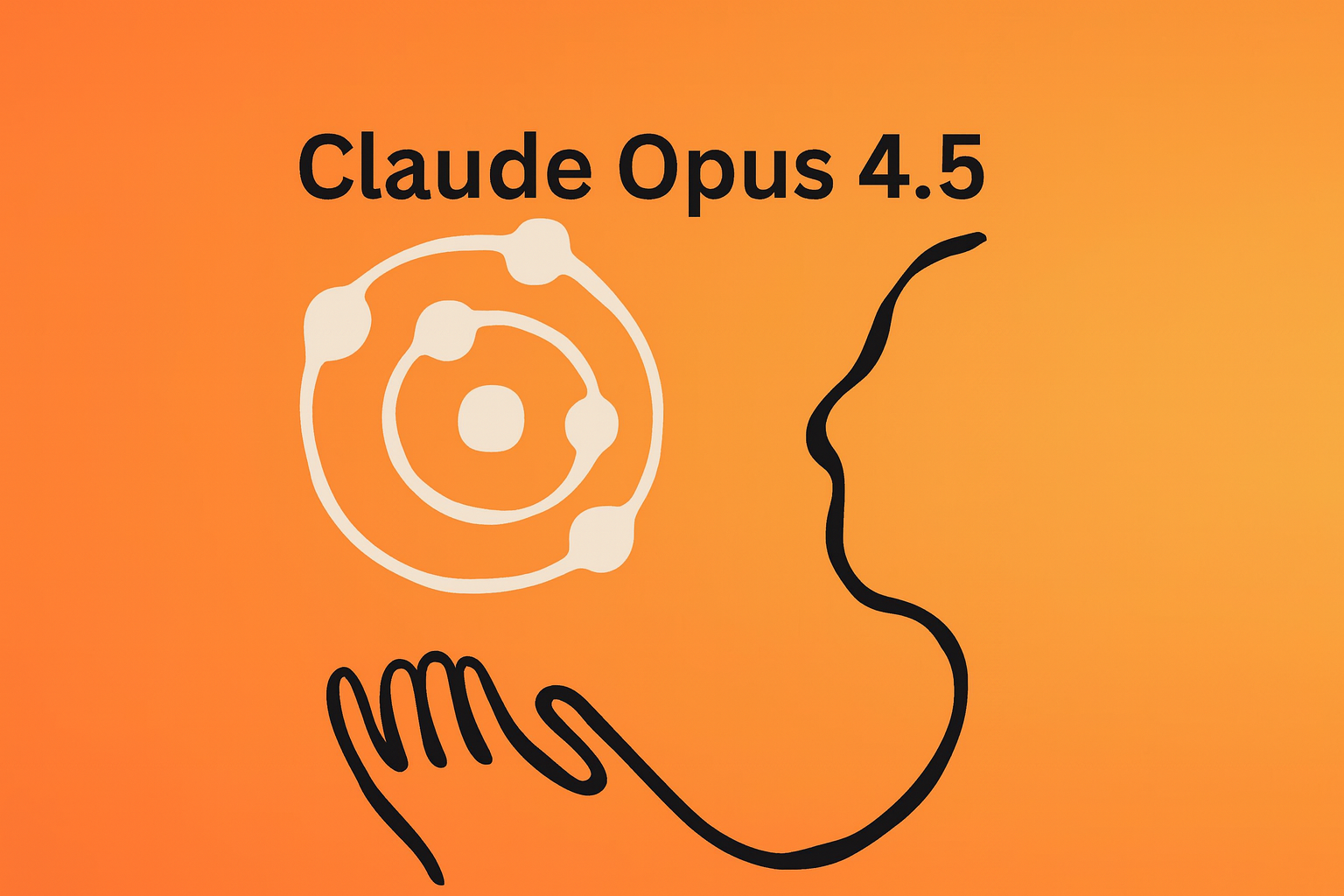
Claude Opus is Anthropic’s highest-end AI model, designed for users who need the most advanced reasoning, coding support, and long-context performance the Claude ecosystem can provide. While lighter models focus on speed or affordability, Opus is purpose-built for the hardest problems—research analysis, multi-step planning, enterprise workflows, and complex software engineering. With the expected release of Opus 4.5, the model is poised to take another substantive step forward.
What Claude Opus Does for Users
Claude Opus serves as the flagship “deep-thinking” model in the Claude lineup. It is engineered for work that demands reliable, extended reasoning across multiple steps. Users turn to Opus when they need an AI partner capable of analyzing large documents, orchestrating long workflows, or reasoning through complex problems that require consistent logic over hundreds or thousands of tokens.
Another major advantage of Opus is its capability with large and complicated codebases. It can read, refactor, and troubleshoot multi-file projects, making it valuable for software development teams. Its extended context handling and structured reasoning enable it to understand how changes in one part of a codebase will affect other parts, something smaller models struggle with.
Beyond raw intelligence, Opus is built for practical integration. Its design emphasizes stable tool use, file handling, and agent-style task execution. For users building automated workflows—such as coding agents, research assistants, or internal enterprise systems—Opus provides the reliability and interpretability required for higher-stakes work. It also incorporates strong safety and robustness features, making it suitable for businesses that need models with predictable behavior and compliance-friendly guardrails.
The Benefits Users Experience
Users who rely on Opus typically experience three main benefits. First is heightened reasoning quality: Opus is known for its ability to stay consistent across long chains of logic, making it particularly strong for analysis, planning, and complex instruction following. Second is stronger performance in coding and technical tasks, especially when the work spans large projects or requires precise refactoring and debugging. Third is workflow stability: Opus tends to behave predictably in multi-step processes, tool integrations, and file-based operations, which is essential for enterprise automation and agent systems.
While Opus comes with higher costs compared to mid-tier models, these benefits make it the preferred choice for users working on demanding, high-value tasks where accuracy, depth, or system reliability outweigh raw token cost.
What’s New and Expected in Claude Opus 4.5
Opus 4.5—sometimes referenced by its internal codename—has appeared in technical logs and testing environments, signaling that Anthropic is preparing the next iteration of its premier model. Though not all details are officially published, the current information paints a clear picture of the upgrade.
Opus 4.5 is expected to improve multi-step reasoning and “extended thinking,” allowing the model to handle even longer and more complex workflows with fewer errors. This includes better internal planning, more coherent strategies, and stronger performance when coordinating multi-stage tasks.
Software engineering capabilities are also set to advance. The new version is anticipated to deliver more accurate code generation, more reliable cross-file reasoning, and greater stability when handling refactor operations in very large repositories. This aligns with Anthropic’s recent focus on improving engineering-oriented performance across the Claude family.
Tool use and agent orchestration are another major area of enhancement. Opus 4.5 is expected to manage tool calls more reliably, break tasks into structured subtasks more intelligently, and support more sophisticated automated workflows. These improvements directly benefit users building AI-powered systems that must operate consistently and autonomously.
The update may also include expanded multimodal capabilities, stronger document and image understanding, and enhanced safeguards. Enterprise-grade safety, consistency, and explainability—areas Anthropic has invested heavily in—are likely to be refined further in Opus 4.5.
From a pricing standpoint, Opus 4.5 is expected to remain within the same cost tier as the current Opus versions, continuing to position itself as a high-capability model intended for mission-critical work rather than casual use.
What Users Should Expect
For users who already rely on Opus for large-scale coding, deep research, complex reasoning, or advanced agent workflows, version 4.5 is positioned as a meaningful improvement rather than a minor iteration. Increased reliability, deeper reasoning capability, and smoother integration with tools and agents should make it even more useful for long-horizon tasks.
For lighter use cases, however, Opus may remain more power than necessary—meaning many users will continue to find Sonnet or smaller models sufficient.
If you’d like, I can turn this into a polished blog-ready article, a shorter marketing-style summary, or a more technical analysis.
-

 AI Model2 months ago
AI Model2 months agoHow to Use Sora 2: The Complete Guide to Text‑to‑Video Magic
-

 AI Model4 months ago
AI Model4 months agoTutorial: How to Enable and Use ChatGPT’s New Agent Functionality and Create Reusable Prompts
-

 AI Model5 months ago
AI Model5 months agoComplete Guide to AI Image Generation Using DALL·E 3
-

 AI Model5 months ago
AI Model5 months agoMastering Visual Storytelling with DALL·E 3: A Professional Guide to Advanced Image Generation
-

 AI Model3 months ago
AI Model3 months agoTutorial: Mastering Painting Images with Grok Imagine
-

 News2 months ago
News2 months agoOpenAI’s Bold Bet: A TikTok‑Style App with Sora 2 at Its Core
-

 AI Model7 months ago
AI Model7 months agoGrok: DeepSearch vs. Think Mode – When to Use Each
-

 Tutorial2 months ago
Tutorial2 months agoFrom Assistant to Agent: How to Use ChatGPT Agent Mode, Step by Step
